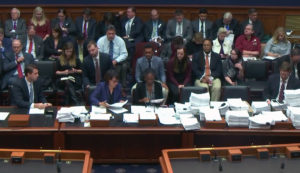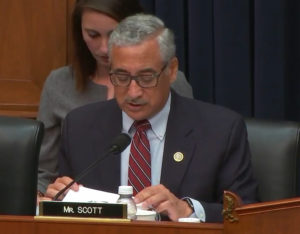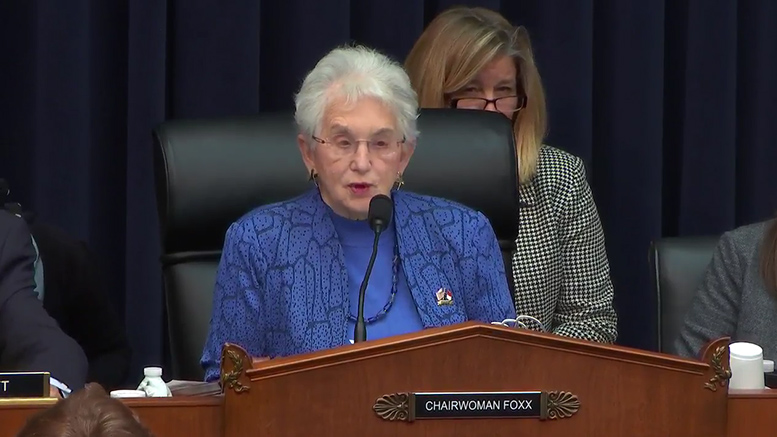The House Education and the Workforce Committee on Tuesday began to mark up its bill to revamp the Higher Education Act, which kicked off with a partisan yet cordial tone.
Democrats argued that H.R. 4508 would shrink college access for low-income students and benefit for-profit institutions. Republicans contended that the federal student aid system is cumbersome, ineffective and driving up college costs for students.
“We are in the business of reforming higher education, not just reauthorizing the Higher Education Act,” said Rep. Brett Guthrie (R-Kentucky), co-sponsor of the bill and chair of the panel’s higher education subcommittee. “A simple reauthorization of the 1965 law will not address the needs of our current workforce that is over 6 million skilled workers short, nor will it reverse the $1.4 trillion of outstanding student loan debt that is placing a drag on the economy.”
Democrats criticized GOP committee leaders for providing only 10 days to review the nearly 600-page bill and dozens of proposed amendments before the mark up. (The American Association of Community Colleges also noted the short time frame in a letter to committee leaders stating that it does not support the current bill.)
“We’re reviewing things as we go,” said Rep. Blunt Rochester (D-Delaware), who noted members of both parties should take more time to review the bill. “Let’s slow the train so we can get on.”
Committee Chair Virginia Foxx (R-North Carolina) cited previous mark ups — when Democrats had the majority — where bills were introduced and marked up the next day.
Wide-ranging topics
The House bill — dubbed the PROSPER Act (Promoting Real Opportunity, Success and Prosperity through Education Reform) — would significantly change federal student aid, such as allowing students to tap Pell grants to pay for short-term education programs and permitting colleges to limit student borrowing. It also would require higher education institutions to cover certain portions of student aid if students drop out.
Both parties were prepared to introduce dozen of amendments that addressed Pell grants, for-profit accountability, opioid prevention, student loan forgiveness, teacher preparation programs and Dreamers, among other issues. (Editor’s note: The markup was still in session at our press time, though Foxx expected a vote on the bill.)

House committee staffers prepare amendments to distribute to committee members.
In casting his support for a Democratic amendment to increase the maximum Pell award by $500, index it to inflation and increase eligibility, Rep. Gregorio Kilili Camacho Sablan (D-Northern Mariana Islands) noted that 86 percent of the 1,100 students at Northern Marianas College — a community college located at the commonwealth — receive Pell grants. Most of these students also work and take care of their families, and rely on Pell to attend college.
Democrats also argued that the bill would again open student aid to potentially unscrupulous for-profit institutions. They introduced an amendment to restore the “90-10 rule” that would hold for-profits more financially liable to participate in federal aid programs.
While Democrats were calling to include certain safeguards, Republicans argued that many of the current requirements provide little results and only hamper colleges with overly burdensome paperwork.
Unit-record data debate
A manager’s amendment to the bill would include new language to direct the U.S. Education Department to study the feasibility of having the National Student Clearinghouse set up a data system to analyze institution- and program-level student outcomes. Democrats introduced an amendment — that was defeated — to eliminate a ban on student-level record data, noting that without a repeal, the bill’s language was “an empty gesture.”

Rep. Bobby Scott (D-Virginia) makes the case for federal student-unit data.
Such a unit record system, which AACC supports, would allow colleges to capture data on veterans, transfer students, part-time students and others not currently included in federal data, said Mark Takano (D-California), a former trustee at Riverside Community College District. The data would inform practical policy to help students succeed, especially those at community colleges.
“Too many students remain missing from the college completion matrix,” added Ranking Member Bobby Scott (D-Virginia), who noted the data could also help determine how well college programs serve students by gauging how students are doing 10 to 15 years after completing their credentials.
But Foxx, a long opponent of such a system, lead the vote in opposing the amendment, saying it would “sacrifice the privacy” of students not receiving federal student aid.
Some common ground
Although most of the amendments voted on up to our press time fell along party lines, there were a few that were supported by both sides, including one from Democrats to support evidence-based programs for drug and opioid prevention programs provided by colleges, and one from Republicans for the U.S. Education Department to report on efforts to educate high school students and families about financial literacy and student aid.

